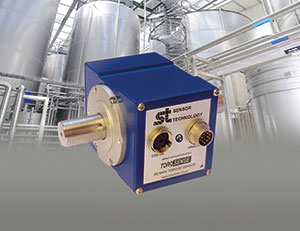

Factory automation continues to develop year on year and pumps are increasingly required to supply real-time operating data to control networks so that their performance can be monitored and adjusted to meet constantly changing production requirements.
Hardwiring a sensor into a pump’s rotating drive shaft usually requires the use of a delicate slip ring, but an alternative solution is to use a non-contact radio frequency detector, as Mark Ingham of Sensor Technology in the UK explains. However, such advances are not without their difficulties, one such being the need to connect machines and equipment such as pumps, mixers and conveyors to the control computers. Wiring up one machine is not a great task, but a highly automated factory will have literally hundreds of them, so the task becomes considerable.
One of the most time-consuming tasks is fitting torque sensors to rotating equipment, as this requires the use of fiddly and fragile slip rings. However, torque is a key performance indicator. For instance, a gradual increase in a pump’s torque may suggest increasing flow to compensate for growing leakage; a sudden increase may indicate a blockage downstream of the pump, while a sudden reduction may be due to an upstream blockage.
So, in automated plant it is well worth measuring torque, but can fitting a suitable sensor be made quicker, easier and therefore more cost effective?
The answer to this question is yes. TorqSense is a wireless sensor that replaces the need for physical wiring and slip rings with radio wave communications. Fitting a TorqSense typically takes about one-fifth the time required for a conventional hardwired transducer.
So how do they work?
TorqSense transducers use two surface acoustic wave (SAW) devices, which are attached to the surface of the shaft. When torque is applied, the SAWs react to the applied strain and change their output. The SAW devices are interrogated wirelessly using RF, which passes the SAW data to and from the electronics inside the body of the transducer. Ingham explains: “All you have to do is set up a TorqSense is glue the SAWs to the shaft, fire radio waves at them and monitor the waves that are reflected back. The SAWs are distorted in proportion to the twist in the shaft, which in turn is proportional to the level of torque. The frequency of the reflected waves is changed in proportion to the amount of distortion, and electronics within the TorqSense analyses the returning wave and feed out torque values.
“As the TorqSense method does not require contact with the rotating shaft, it offers complete freedom from the slip rings, brushes or other solutions found in traditional torque measurement systems. TorqSense devices also have a high immunity to magnetic forces, allowing their use in, for example, motors where other technologies are very susceptible to electronic interference.”
Applications
SAW-based torque sensors have been used around the world and in many fields, from test rigs to wind turbines and generators based on tidal or river flows. They are used extensively in the high-tech world of the development of engines and gearboxes for Formula 1 and other hyper performance cars. Torque feedback systems have also been used by security firms to determine the direction their movable CCTV cameras are facing so that they can efficiently watch premises under their protection, in industrial mixing, long-duration scientific experiments, to model aircraft thrust lift and control systems, etc.
They can be used with virtually all pump-based systems, from micro-dosing of active ingredients in pharmaceutical production, to cake filling injection in high-volume bakeries, to lubricant and coolant circulation in manufacturing machinery, to flow control in industrial washing machines and paint spray robots; they can prove invaluable when coupled with the giant pumps used for fresh water distribution, wastewater handling and flood management systems. Their potential uses with pumps are almost unlimited.
| Tel: | +27 10 595 1831 |
| Email: | [email protected] |
| www: | www.instrotech.co.za |
| Articles: | More information and articles about Instrotech |

© Technews Publishing (Pty) Ltd | All Rights Reserved